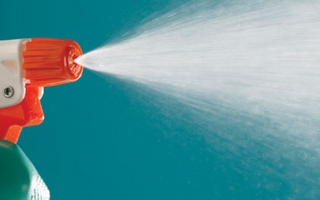 Apparently, the cure for nasty foodborne pathogens has been hiding in our yogurt all along. Lactic acid, which is a product of nature and dissolves without any chemical residue, is one of many natural acids fighting the good fight against pathogens on carcasses today.
Apparently, the cure for nasty foodborne pathogens has been hiding in our yogurt all along. Lactic acid, which is a product of nature and dissolves without any chemical residue, is one of many natural acids fighting the good fight against pathogens on carcasses today.“The poultry and beef industry are willing to try new things to receive the best value for their price and stay ahead of government regulations regarding Campylobacterand Salmonellalevels,” says Scott Russell, Ph.D., professor of poultry processing and products microbiology, poultry science department, University of Georgia.
Lactic acid, a peroxyacetic acid, has been used as a sanitizer since the mid-1990s but has gained attention recently for its effectiveness against E. coliO157:H7 and the non-O157:H7 adulterants.
Last fall, Colorado State University released a study validating that lactic acid can reduce microbial contamination, including E. coliand Shiga toxin-producing E. coli, on beef carcass surfaces when used as a food-safety intervention.
“In all cases, whether it’s trimmings or chilled beef, lactic acid is effective,” says Keith Belk, Ph.D., professor, Center for Meat Safety & Quality, department of animal services, Colorado State University, who worked on the study. “The price of lactic acid fluctuates, but it’s pretty cheap and efficient. However, it can’t be a substitute for good prerequisite programs.”
WHAT’S OLD IS NEW AGAIN
The chicken industry has also explored using non-chlorine-based sanitizers to improve food safety and product quality. Intervention technologies and applications have been widely adapted and introduced into the slaughter and processing process over the last decade.
“Such innovations include several approved antimicrobial chemical rinses, dips and washes to reduce contamination within a process,” says Ashley Peterson, Ph.D., vice president of scientific and regulatory affairs, National Chicken Council. “These approved antimicrobials offer an alternative to chlorine and have demonstrated to be more effective than chlorination when used at key intervention steps in the process; for example, pre- and post-chill sprays/dips, chillers, scalders, inside-outside bird washes and rinses/dips in further processing, to name a few.”
Other chicken processors are adjusting the pH level of chlorine (lowering it, in fact) in their sanitizers to shift the state of chlorine so it is more effective, notes Russell.
Chlorine may not currently be used as often for decontaminating poultry carcasses, but rather is used more often for cleaning food contact surfaces of facilities as part of prerequisite sanitation programs, says Matthew Taylor, assistant professor, meat science, Texas A&M University.
“Chlorine can also be applied in a gaseous state on red meat, carcasses, whole or eviscerated poultry carcasses and [in] water use, according to current USDA/FSIS approvals outlined in FSIS Directive 7120.1, Revision 13,” he says.
Another oldie but goodie that is receiving new attention is cetylpyribinium chloride, an antiseptic that has been used in throat lozenges and mouthwash for decades, as well as in surface disinfectants.
“It represents a new class of compounds that bridges the gap from clean surfaces to carcasses,” says Russell.
A number of processors are using Quaternary Ammonium Compounds (QAC), such as cetylpyridinium chloride (CPC), for sanitizing processing areas such as the facility, surfaces and in some cases, carcass chiller waters, notes Taylor.
“Cetylpyridinium chloride is approved by the USDA/FSIS for cleaning the surface prior to or after chilling, but it must be removed from the carcass,” he says.
OPTIMIZING SAFETY AND QUALITY
Processors are also combining strong and weak acid mixtures, such as hydrochloric acid mixed with citric acid or sulfuric acid mixed with ammonium sulfate, to clean chickens. “These mixtures are also used to reduce the pH level in water that has chlorine,” says Russell.
He notes that all sanitizing methods must be applied in such a manner that they contact the bacteria to eliminate it, and the chemical residue must then be removed from the chicken product before it reaches the grocery store.
Sanitizers are on the front burner today, as researchers at the University of Nebraska coordinate a multi-disciplinary, five-year study funded by a USDA grant on Shiga toxin-producing adulterants, from risk assessment, quantification and interventions for all stages of the food chain.
Another study at Texas A&M University is investigating electrostatic spraying as a viable technology for gaining optimal carcass coverage with approved antimicrobials, says Taylor.
“Even companies with the best R&D have no reason to not continually test and optimize their product and processing systems,” he says. “They can help identify ways to optimize their product safety and quality, improve and further understand the limits of the technologies used in processing and retain assurance that their processing procedures are functioning in the best way they can.”





